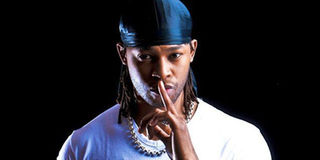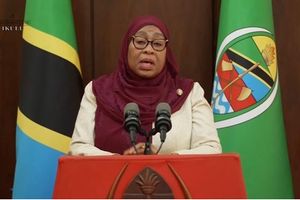Redsan: 18 years on and still relevant

Kenyan musician Redsun in an earlier photograph.
PHOTO | NMG
What you need to know:
Redsan appeared on Mizizi, one of the first shows to promote local artistes together with fellow future hall of famers Chameleone and Bebe Cool.
Nairobi. Before he unleashed megahits like ‘Julie’, ‘Touch’ or ‘Nakutaka’, Redsan was a little known artiste struggling to get his music heard like every other artiste.
To make it worse, radio stations then – KBC and Capital FM – were not playing a lot of Kenyan music.
Music studios were far and in between; Sync Sound Studios owned by Ted Josiah closed down and the other, Johari, owned by Bruce Odhiambo, would only take in a few artistes for commercial purposes.
“Ogopa deejays was the first music studio to take Kenyan music public. But the morale was so low because no one was interested in buying local content or playing Kenyan music. When Kiss FM came into the market I took my first single there, and they were like ‘who are we going to sell this to’?” Redsan recalls.
“We sold music out of our car trunks, even clubs didn’t play our music and I had to do free shows just to get my name out there,” he tells Buzz.
Redsan appeared on Mizizi, one of the first shows to promote local artistes together with fellow future hall of famers Chameleone and Bebe Cool.
Watching them back then, you could see the scrawny artiste was on a mission to take over the music industry. All that is now a distant memory for Redsan, aka Swabri Mohamed, who without a doubt knows and is not afraid to tell you, he is the biggest name in dancehall music in the country.
He is a pioneer who has managed to achieve longevity in the game where most of his peers fell off by the wayside. A game changer who was influential in making Kenyan and Ugandan music meet.
With hits such as ‘Wanipa Raha’, ‘Chicken’, ‘Step On It’, ‘Badder Dan Most’ and ‘Shoulder Back’, he is undoubtedly one of the biggest names but did he, somewhere along the line, miss out on becoming the biggest artiste in Kenya.
“I Joined Chameleone and Bebe Cool on tour, to build the East Africa market because every country then was doing their own thing. It was a hard road, so when someone asks is Redsan the biggest brand in Kenya? Yes I am. I know where I’ve come from and where I have built this brand from,” he says.
He adds: Which artiste is there right now since we started in 1998 consistently? Give me one name.
Talent, good management, believing in God and valuing oneself is what Redsan believes stamps him as a top tier artiste to date.
“I have four albums which have done fairly well in the international market and gave me international recognition, the fifth album is going to be my biggest album yet featuring big artistes. So yes, from Kenya, I’m the biggest brand,” he says.
But could his strong sense of confidence be misconstrued for a big ego?
“I have four albums, I’ve performed in many countries than any artiste here. Tell me one artiste that has gone to the countries I have, not once, not twice but multiple times. It’s not ego, it is hard work. Sometimes when you tell people about your hard work or your projects they confuse that for an ego. How long have I been in the industry? Since ‘Julie’, so let’s give respect where it’s due,” he says. His competition, he says, are the likes of dancehall new superstars Patoranking and Burna Boy in Nigeria, and Stonebwoy from Ghana.
Bien-Aime Baraza has a lot of respect for the pioneer dancehall star who he says has ‘achieved legendary status’.
“I’m a huge Redsan fan to a point that I get star struck when I see him. This is a guy that I used to listen to in primary and high school, he was the bomb then and still is,” says Baraza.
Whether he is the biggest artiste in Kenya or not, Baraza says it may be a strategic plan by Redsan and that perhaps, this is the level he wants to be at right now.
“Shoulder Back is a hit, that means he is doing something right. He is the first artiste I ever saw with a bouncer guarding him in a club. He has made himself inaccessible and has maintained relevance through mystery,” says Baraza, adding that “he is talented than every dancehall artiste in Kenya.
The Wanipa Raha hitmaker was already doing music around the same time that Nigeria’s P Square were just getting known in Kenya.
But right now, P Square command a global audience that has seen them collaborate with American star Rick Ross.
MARKET VS INDUSTRY
“I performed with P Square when they were not even popular back then, but why have they surpassed us so quickly? It’s because they have an industry, in Kenya we have a music market. Right now where can you buy local music? The biggest distributor we have for local music is Uchumi and Nakumatt, come on.
That’s why the Nigerians and Ghanaians will always kick us. MTV has five shows that play Nigeria music, what about East Africa, Kenya? We need to come together as artistes and set our own pace and standards,” he says.
Speaking of standards, Redsan is on the line up of the “It’s Big” concert set for July 10. It will be Redsan’s second major performance of the year with an impressive lineup of artistes – Alikiba, Radio and Weasel, STL, Jaguar and Timmy T Dat – since January when he headlined the SportPesa Festival. So why would an artiste of such magnitude barely perform in his own country?




